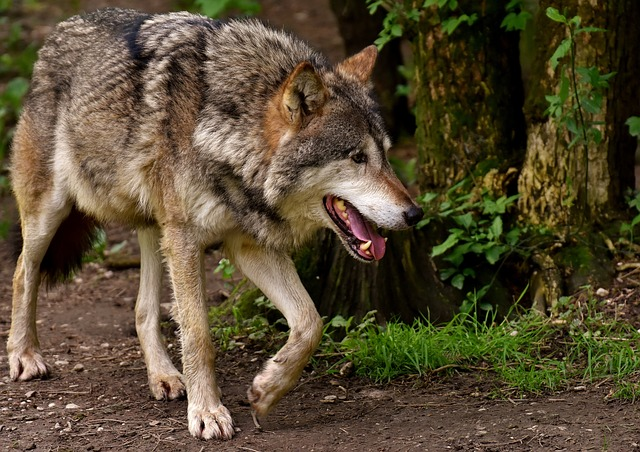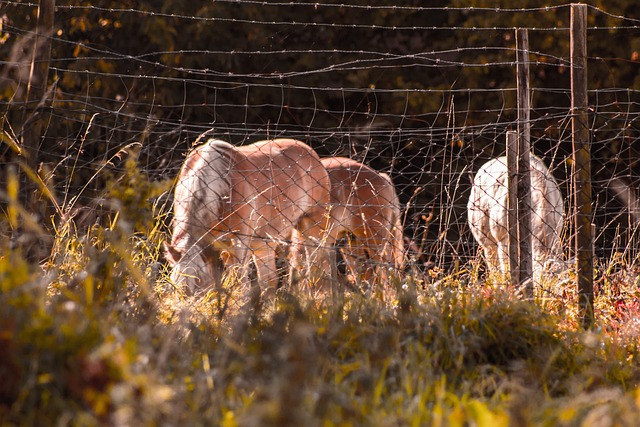You might be surprised to know that a wolf can not climb a tree, although they live in different habitats, including forests, mountains, tundra, grasslands, and deserts.

Moreover, you hardly see any wolves roaming the trees. As wolves are bad at climbing tall trees, they can reach the branches that are not too high through jumping.
Wolves can jump and dig, which is why they are famous for attacking farm animals. Let’s get into more detail on the jumping behavior of wolves and what measures you can take to protect from wolves.
Wolves and Coyote Capacity of Jumping.
Grey Wolves and coyotes are wild animals known for their predatory skills. So when it is about crossing any high wall or fence to prey on livestock, wolves can jump up to 12 feet in the air from standing, while coyotes can jump up to 8 feet.
How High Can Wolves Climb?
Wolves are known for their exceptional characteristics and behavior, from their keen sense of smell to remarkable agility.
While wolves are not good climbers, as they catch prey on land, that is why they can certainly walk on steep terrain and navigate rocky landscapes.
Moreover, wolves have been observed climbing slopes as steep as 45 degrees, using their powerful legs and sharp claws to maintain their balance.
Wolves climb trees but can not reach high as other climbing animals can. For wolves reaching up to the tree branches 11 feet from the ground is quite easy. Depending on how much branched a tree is and what is the condition of a wolf.
Do Coyote Rollers work?
The coyote roller is a popular tool for keeping coyotes and other predators out of yards, gardens, and farms. The concept behind coyote rollers is simple yet effective. The roller is mounted along the top of a fence or walls.

So, when a coyote, wolf, or other predator attempts to climb over it, the roller spins, and the animal falls back to the ground.
Coyote rollers are highly effective at keeping coyotes out, and they can also be used to deter other animals like raccoons and opossums.
However, it’s important to note that coyote rollers should not be the only method to deter coyotes, as they may still find other ways to enter an area if they are highly enthusiastic.
Coyote rollers are tubular rails that are installed on top of fences. These rollers have gained popularity as a deterrent. These rollers make it difficult for coyotes to gain traction and climb over fences.
Generally speaking, they work well, but their effectiveness may depend on other factors, such as the size of the fence or wall and the terrain.
How should an ideal fence or wall against wolves and coyotes be designed?
If you live in wolf territory, you understand how important strong and proper fencing for safety is. An ideal fence or wall should be at least 6 feet high and buried 1 foot into the ground to prevent entrance through digging.
It should also be made of materials difficult for wolves and coyotes to climb, such as chain-link, woven wire, or solid wood. Adding a top extension or angled outriggers can also prevent climbing.
It’s also important to regularly check the fence or wall for any holes or weak spots that these predators could exploit.
Additionally, clearing any bush or vegetation around the fence or wall will prevent predators from using it to hide.
It is recommended that the vertical height of the fence should be 8.2 feet with an addition of 1m overhang with an upward angle into the enclosure between 35 to 45 degree that act as a blockage.
Properly designing a fence or wall is crucial to protect against wolves, and coyotes are crucial to ensuring the safety and well-being of livestock.
Is Climbing Trees Effective in Escaping a Wolf Attack?
Wolf attacks can be extremely frightening and life-threatening, and it’s important to know how to protect yourself if you’ll ever get stuck unluckily in it.
Many people believe that climbing a tree is an effective way to escape from a wolf attack, but the truth is, it may not be the best response.
While climbing a tree, you find nearby could be helpful, especially if your climbing ability is high enough to get out of reach of the wolf. It’s important to remember that wolves can jump vertically over 6 feet and climb trees with low-hanging branches.
Additionally, if you climb a tree, the wolf may wait for you to come down. Wolves are highly intelligent and patient predators, and they may be willing to wait hours for you to make a mistake and come down from the tree.
Reasons Wolves Can’t Climb Trees
Wolves are tenacious creatures known for their incredible speed, strength, and agility. However, despite their impressive physical abilities, wolves cannot climb trees. This is due to several factors that make tree-climbing impossible for these animals.
Firstly, wolves lack the physical adaptations necessary for climbing. Unlike animals such as squirrels or monkeys, wolves do not possess opposable thumbs or prehensile tails, which are crucial for grasping onto branches and manoeuvring through trees.
Additionally, their paws are not designed for gripping onto vertical surfaces. Like tree bark, they are better suited for running and hunting on flat terrain.
Another reason why wolves cannot climb trees is their powerful body mass. Adult wolves can weigh up to 175 pounds, making it difficult to balance on thin branches without breaking them.
This makes tree-climbing risky and potentially dangerous for the grey wolf, as they could fall from great heights and get serious injuries.
Rather, they possess sharp teeth and claws, powerful hind legs, and muscular flexibility to hunt animals on land.
Their hunting tactics rely on stealth, speed, and teamwork, rather than tree-climbing skills. As such, there has been no evolutionary pressure on wolves to develop tree-climbing abilities.
Can Wolves Climb Walls?
Unlike cats or monkeys, grey wolves do not have the physical adaptations or abilities to climb walls or vertical surfaces.
Wolves have built-in speed and endurance rather than climbing. Their bodies are designed for running and chasing prey across open terrain, with powerful legs and a lean build that allows them to cover long distances quickly.
While they can jump over obstacles such as fallen trees or rocks, they cannot climb tall trees with high branches.
However, just because wolves cannot climb walls does not mean they are not skilled. They are excellent swimmers and can cross rivers and lakes with ease.
They are also adept at traversing rocky terrains such as mountains and forests, using their keen sense of smell and hearing to locate prey and avoid danger.
Conclusion
Surprisingly, wolves jump high as 12 feet and are extremely agile animals. They use jumping to attack farm animals. But people use the latest tools to protect themselves from wolf or coyotes attack, such as coyote roller and proper fencing.
Moreover, there are many reasons they can not climb trees like they hunt animals on land and their a heavy body weight. But they have impressive jumps and the physical ability to climb lower-branched trees.
Frequently Asked Questions
Can a wolf jump a 6-foot fence?
Wolf can jump walls 6 feet high.
How high can coyotes jump?
Coyotes can jump over the height of 8 feet.
Can wolves jump over fences?
Wolves have the ability to jump over fences.
Can a wolf climb a tree?
Wolves can not reach the tall branches. However, they can climb over the short-branched trees.
How High Can Wolves Jump?
Male wolves can run up to 56 kilometers and jump up to 12 feet.
Are dogs good climbers?
Dogs are not good climbers, as their legs are not formed in such a way that they can get a grip on the surface of the trees.
Can a lion climb tree?
Yes, a lion can climb a tree.









